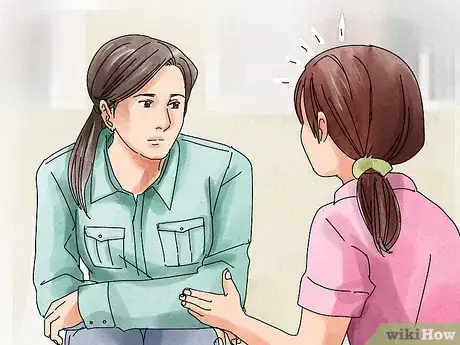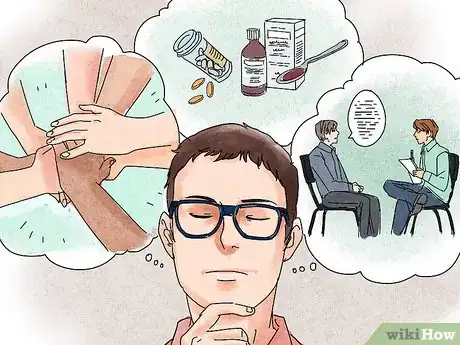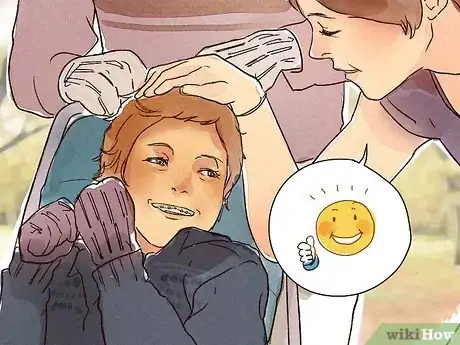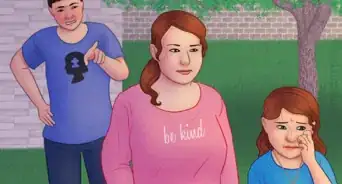This article was co-authored by Iddo DeVries, MA-SLP. Iddo DeVries is a Speech-Language Pathologist and the Owner and Clinical Director of Speech Therapy of DV Therapy, Inc. based in Los Angeles, California since 2014. Focusing on dynamic therapy for individuals and their families, Iddo specializes in family training and speech therapy for disabilities and delays including, autism, late-talkers, PDD, specific language impairments, articulation and phonological disorders, auditory processing delays, stuttering, pragmatic and social delays, Verbal Apraxia of Speech. Iddo holds a BS in Speech Communication Sciences from Brooklyn College and an MA in Speech-Language Pathology from Adelphi University. In 2011 Iddo was awarded the outstanding achievement award in the field of speech therapy by the New York City Department of Education. He has been an active member of the nationally accredited speech board ASHA since 2006.
There are 14 references cited in this article, which can be found at the bottom of the page.
This article has been viewed 67,295 times.
Autism spectrum disorder (ASD) is a neurodevelopmental disability that causes considerable impairment in social interplay and communication, and causes the individual to exhibit atypical behavior and preoccupation.[1] Autistic people respond differently to stimuli, learn differently, and vary in cognitive capabilities. While autism is a lifelong disability, some of its corresponding difficulties can be mitigated or alleviated.
Steps
Getting Help
-
1Seek professional help. Health care providers rely on behavioral symptoms and/or written questionnaires during routine checkups. There are screening tests that can also be done during these visits. If your doctor does not regularly screen for autism, ask for them to do so.
-
2Understand that every autistic person is different. There is no one-size-fits-all approach for autism.[2] Tailor treatment to the individual's needs. Stop asking "What do autistic people need?” and instead ask “What does this specific person need?”
- For example, one autistic person may have excellent self-care skills and above-average school performance, but need sensory integration therapy and social skills training. Another might be highly social but unable to care for herself and in need of counseling for depression.
Advertisement -
3Consider medications. While there is no cure for autism, some of its challenging aspects and comorbid conditions can be helped through medication.
- Anxiety
- Elevated energy level
- Self-injurious behavior
- Inability to concentrate
- Depression
- Seizures
- Severe outburst of anger or aggression
-
4Consult with your health care provider to ensure your loved one is receiving the proper treatments for their individual needs.
-
5Consider comorbid conditions. Many autistic people also experience comorbid disabilities/health conditions, such as anxiety disorders, epilepsy, digestive issues, depression, ADHD, oppositional defiant disorder, schizophrenia, and more. These are all treatable.
Choosing Therapies
-
1Try the Rapid Prompting Method (RPM) for developing communication skills, especially for nonverbal autistic people.[3] Rapid prompting involves continuously asking questions to the autistic person, and letting them answer using writing, pointing to a letter board, speaking, or whatever works best. It encourages the autistic person to communicate and engage with the world more.
-
2Consider Relationship Development Intervention (RDI) to teach social skills. RDI focuses on developing skills such as theory of mind, independent thinking, consideration of others, and more.[4] It is a long-term therapy.
-
3Consider behavioral therapies such as ABA, with caution. Behavioral therapy can teach rote tasks using extrinsic rewards, and can be useful for concrete skills such as hand-washing, listening to the word "stop," and tying shoes. Unfortunately, there are many stories of goals that involve compliance,[5] forced normalization,[6] and abuse. Choose therapists carefully and make sure the focus is on teaching your loved one skills, not on forcing them to conform.
-
4Try Cognitive Behavioral Therapy (CBT) to help with anxiety and depression, which often accompany autism. CBT is a form of talk therapy that can help identify distorted thoughts, such as "Everybody will laugh at me if I flap my hands" or "I am a burden to my family," and evaluate their accuracy.
-
5Try Sensory Integration Therapy and a sensory diet to help with sensory issues. An occupational therapist can work with you and/or your loved one to provide strategies to meet the autistic person's needs.
- A sensory diet is a set of activities to do at home, like climbing trees, finger painting, swinging, and blowing bubbles. It can help meet the autistic person's sensory needs and acclimate them to various stimuli. It can also be a lot of fun.
- The therapist can also help redirect harmful stims (e.g. hitting one's head) towards ones that fulfill the same need without causing harm (e.g. hitting a pillow, applying deep pressure to the head).
-
6Try Augmentative Alternative Communication.[7] AAC is not a therapy so much as a way for autistic people to communicate. This method uses technology and can help people who have trouble verbalizing their needs. The autistic person may use a device like an iPad to pull up pictures and symbols. They then use these images to communicate their wants and needs.[8]
-
7Consider complementary and alternative treatments. There is no scientific evidence that any of them are helpful at all, some involve specific risks, but certain people find them useful. The following is a list of treatments that fit this category and examples of what they may involve:
- Energy therapy - reiki, acupuncture, Therapeutic Touch
- Alternative medical systems - aromatherapy, homeopathy
- Manipulative and body-based method - deep pressure, acupressure, hydro massage
- Mind-body intervention - auditory integration, meditation, dance therapy
- Biologically based therapy - using herbs, special diet, and vitamins
- Always consult a doctor before making a major change to your own or a loved one's diet or lifestyle. Some alternative therapies, such as chelation therapy or MMS, are potentially deadly.[9] [10] If the autistic person is upset by the therapy, or fails to improve, find a new therapy.
-
8Watch for fake therapies and false claims. From common snake oil peddlers to certified BCBAs, there are people who will distort truths and support ideas that can harm you or your loved one. Trust your instincts, don't let fearmongering make you panic, and don't continue a therapy if you think it is upsetting you or your loved one too much.
- Therapy should not be extremely painful or distressing. A therapist should take the patient's unhappiness seriously.
- 40 hours per week of therapy is as intense as a full-time job. This can be overwhelming. Small children do not have adult attention spans. Your child will be fine with 1-2 hours per day or less, and there's no rush.[11] [12]
- Transparency is a reasonable request. Therapists should not prevent you from witnessing a situation, or dodge your questions.
- People who claim to cure autism are not being honest. Autism is probably genetic, not caused by vaccines or parasites.
- Your instincts matter. If a therapist is telling you to ignore your gut feeling, that you're being irrational, or that you would intervene if you saw what they were doing to your loved one, this is a problem.
Creating a Positive Environment
-
1Treat your loved one with kindness and respect. Autistic people can undergo tremendous amounts of pressure to perform "normally,"[13] and the best way to help them is to respect them.[14] Make it clear that you will listen to them. If they feel supported at home, they will communicate and adapt better, and feel happy.
-
2Talk to your loved one often to encourage communication. Children learn to understand speech by hearing others speak, and talking to an uncommunicative person will encourage them to open up (even if the conversations are fairly one-sided for now). If you know what their special interests are, start conversations about them.
- Read their body language as you talk to them. For example, if you ask your daughter "Did you play with your friends today?" and she squeals happily and waves her arms, this is her answer. This communication is a stepping stone and should be encouraged.
-
3Presume competence. Act with the assumption that your loved one can hear and understand you, even if it doesn't look like it. Treat them like they are fundamentally good and intelligent. Positive expectations can help them bloom.
- If your loved one is in the room, assume they can hear what you're saying. If you talk about how hard it is to live with an autistic child, they'll worry that they make your life worse by existing.[15] Save your adult fears for when the children are out of the room.
-
4Be transparent about what's going on. Let them know that they're autistic. This can help them have words for their experiences, and dispel any confusion that they're "broken" or "bad." Let them know that they're just different, that this is okay, and you love them for who they are.
Expert Q&A
Did you know you can get expert answers for this article?
Unlock expert answers by supporting wikiHow
-
QuestionHow can I communicate with an autistic person?
 Iddo DeVries, MA-SLPIddo DeVries is a Speech-Language Pathologist and the Owner and Clinical Director of Speech Therapy of DV Therapy, Inc. based in Los Angeles, California since 2014. Focusing on dynamic therapy for individuals and their families, Iddo specializes in family training and speech therapy for disabilities and delays including, autism, late-talkers, PDD, specific language impairments, articulation and phonological disorders, auditory processing delays, stuttering, pragmatic and social delays, Verbal Apraxia of Speech. Iddo holds a BS in Speech Communication Sciences from Brooklyn College and an MA in Speech-Language Pathology from Adelphi University. In 2011 Iddo was awarded the outstanding achievement award in the field of speech therapy by the New York City Department of Education. He has been an active member of the nationally accredited speech board ASHA since 2006.
Iddo DeVries, MA-SLPIddo DeVries is a Speech-Language Pathologist and the Owner and Clinical Director of Speech Therapy of DV Therapy, Inc. based in Los Angeles, California since 2014. Focusing on dynamic therapy for individuals and their families, Iddo specializes in family training and speech therapy for disabilities and delays including, autism, late-talkers, PDD, specific language impairments, articulation and phonological disorders, auditory processing delays, stuttering, pragmatic and social delays, Verbal Apraxia of Speech. Iddo holds a BS in Speech Communication Sciences from Brooklyn College and an MA in Speech-Language Pathology from Adelphi University. In 2011 Iddo was awarded the outstanding achievement award in the field of speech therapy by the New York City Department of Education. He has been an active member of the nationally accredited speech board ASHA since 2006.
Speech-Language Pathologist
Warnings
- Only try to fix the behaviors that actually cause problems, as 'fixing' harmless odd behaviors will just damage your loved one's self-esteem.⧼thumbs_response⧽
- Be aware of potential comorbid conditions. These include anxiety, depression, epilepsy, attention deficits, sensory concerns, schizophrenia, sleep difficulties, or gastrointestinal problems.⧼thumbs_response⧽
- Never tell a child that autism is a disease without a cure, or that they are a burden to the family. Many autistic adults struggle with self-esteem as a result of damaging rhetoric.[16]⧼thumbs_response⧽
References
- ↑ Iddo DeVries, MA-SLP. Speech-Language Pathologist. Expert Interview. 28 August 2020.
- ↑ Iddo DeVries, MA-SLP. Speech-Language Pathologist. Expert Interview. 28 August 2020.
- ↑ http://autism.about.com/od/alternativetreatmens/f/rpm.htm
- ↑ http://www.rdiconnect.com/about-rdi/
- ↑ http://www.sentex.net/~nexus23/naa_aba.html
- ↑ http://juststimming.wordpress.com/2011/10/05/quiet-hands/
- ↑ Iddo DeVries, MA-SLP. Speech-Language Pathologist. Expert Interview. 28 August 2020.
- ↑ Iddo DeVries, MA-SLP. Speech-Language Pathologist. Expert Interview. 28 August 2020.
- ↑ http://www.webmd.com/brain/news/20050826/boy-dies-after-controversial-treatment-for-autism
- ↑ http://www.bbc.com/news/uk-england-london-33079776
- ↑ https://restlesshands42.wordpress.com/2016/02/19/and-yet-again-aba-whats-wrong-with-it-and-what-can-be-changed/
- ↑ http://michellesuttonwrites.com/2015/11/16/the-letter-i-wish-i-had-read-when-my-children-were-diagnosed-with-autism/
- ↑ http://www.thinkingautismguide.com/2014/02/do-me-favor.html
- ↑ http://www.thinkingautismguide.com/2014/10/dr-jonine-biesman-avoiding-crises.html
- ↑ http://www.buzzfeed.com/bradesposito/letter-viral-aus#.imyDXKperQ
- ↑ http://autisticadvocacy.org/2012/06/you-are-not-a-burden/
- http://www.cdc.gov/ncbddd/autism/index.htm
About This Article
While there is no cure for autism, you can help a loved one with autism who is uncommunicative by talking to them often. Try starting conversations with them about their special interests, which might help them open up. Even if the conversations are fairly one-sided at first. As you talk to them, read their body language and encourage any physical signs of happiness, like squealing or arm waving, so they can learn to communicate better. If your loved one has sensory issues, try going on a sensory diet, which is a set of activities to do at home, like climbing trees or finger painting, that helps acclimate them to different stimuli in a fun way. No matter how your loved one is affected by autism, make sure to ask a medical professional about the best therapies and treatments to accommodate their needs. For more advice, including how to develop communication skills through Rapid Prompting, read on.







-Step-8.webp)





































































Medical Disclaimer
The content of this article is not intended to be a substitute for professional medical advice, examination, diagnosis, or treatment. You should always contact your doctor or other qualified healthcare professional before starting, changing, or stopping any kind of health treatment.
Read More...